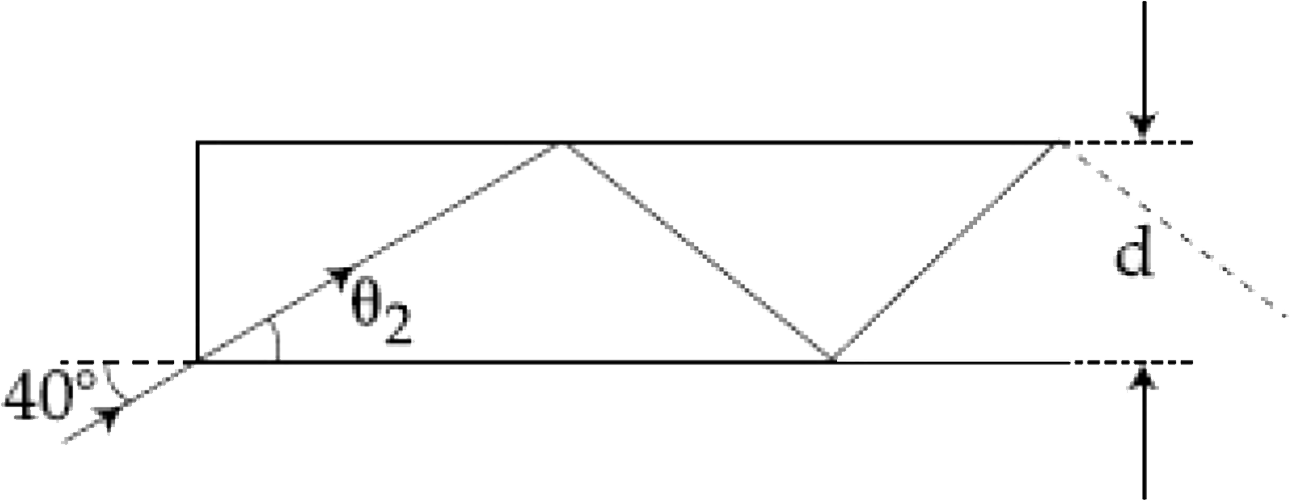Find out no. of reflection after which right Ray will exit from (Given sin40∘=0.64) (A) 130000 (B) 57803 (C) 140000 (D) 150000
To solve the problem of finding the number of reflections after which a light ray will exit from a medium with given parameters, we can follow these steps:
Step 1: Identify the given data
- Refractive index of the medium (n1) = 1.31
- Refractive index of air (n2) = 1
- Angle of incidence (i) = 40 degrees
- Given: sin(40 degrees) = 0.64
Step 2: Use Snell's Law to find the angle of refraction (R)
According to Snell's Law:
n1⋅sin(i)=n2⋅sin(R)
Substituting the known values:
1.31⋅sin(40∘)=1⋅sin(R)
1.31⋅0.64=sin(R)
Calculating this gives:
sin(R)=0.8384
Now, we find R:
R=sin−1(0.8384)≈57.5∘
Step 3: Calculate the critical angle (θc)
The critical angle can be calculated using:
n1⋅sin(θc)=n2⋅sin(90∘)
1.31⋅sin(θc)=1⋅1
sin(θc)=11.31≈0.7634
Calculating the critical angle:
θc=sin−1(0.7634)≈49.5∘
Step 4: Determine if total internal reflection occurs
Since the angle of incidence (i = 40 degrees) is greater than the critical angle (θc ≈ 49.5 degrees), total internal reflection will occur.
Step 5: Calculate the distance between reflections
Using the geometry of the situation, we can find the distance (d) between the reflections. The distance can be calculated using:
tan(R)=hd
Where h is the height of the triangle formed by the reflections. For a triangle with an angle of 30 degrees:
tan(30∘)=hd
From geometry, we can express:
d=htan(30∘)=h⋅√3
Step 6: Calculate the number of reflections in a given length
If we consider a length of 2 meters (2000 mm) of the medium, we can find the number of reflections (N) using the formula:
N=Ld
Where L is the total length of the medium.
Step 7: Substitute the values to find N
Using the previously calculated distance between reflections, we can find:
N=2000mm20√3×10−6m
Calculating this gives:
N≈57803
Conclusion
Thus, the number of reflections after which the light ray will exit from the medium is approximately 57803.
- Refractive index of the medium (n1) = 1.31
- Refractive index of air (n2) = 1
- Angle of incidence (i) = 40 degrees
- Given: sin(40 degrees) = 0.64
According to Snell's Law:
n1⋅sin(i)=n2⋅sin(R)
Substituting the known values:
1.31⋅sin(40∘)=1⋅sin(R)
1.31⋅0.64=sin(R)
Calculating this gives:
sin(R)=0.8384
Now, we find R:
R=sin−1(0.8384)≈57.5∘
The critical angle can be calculated using:
n1⋅sin(θc)=n2⋅sin(90∘)
1.31⋅sin(θc)=1⋅1
sin(θc)=11.31≈0.7634
Calculating the critical angle:
θc=sin−1(0.7634)≈49.5∘
Since the angle of incidence (i = 40 degrees) is greater than the critical angle (θc ≈ 49.5 degrees), total internal reflection will occur.
Using the geometry of the situation, we can find the distance (d) between the reflections. The distance can be calculated using:
tan(R)=hd
Where h is the height of the triangle formed by the reflections. For a triangle with an angle of 30 degrees:
tan(30∘)=hd
From geometry, we can express:
d=htan(30∘)=h⋅√3
If we consider a length of 2 meters (2000 mm) of the medium, we can find the number of reflections (N) using the formula:
N=Ld
Where L is the total length of the medium.
Using the previously calculated distance between reflections, we can find:
N=2000mm20√3×10−6m
Calculating this gives:
N≈57803
Thus, the number of reflections after which the light ray will exit from the medium is approximately 57803.
Similar Questions
The point on the axis which is equidistant from (-4,0) and (10,0) is ,
a) (7,0)
(b) (5,0)
c) (0,0)
d) (3,0)
View SolutionThe point on the axis which is equidistant from (-4,0) and (10,0) is ,
a) (7,0)
(b) (5,0)
c) (0,0)
d) (3,0)
View SolutionThe point on the axis which is equidistant from (-4,0) and (10,0) is ,
a) (7,0)
(b) (5,0)
c) (0,0)
d) (3,0)
View SolutionA ray of light is incident along a line which meets another line, 7x−y+1=0, at the point (0, 1). The ray isthen reflected from this point along the line, y+2x=1. Then the equation of the line of incidence of the ray of light is (A) 41x+38y−38=0 (B) 41x−38y+38=0 (C) 41x+25y−25=0 (D) 41x−25y+25=0
View SolutionFind the coordinates of the point equidistant from the four points A(0,0,0) , B (a,0,0) , C(0,b,0) and D(0,0,c) .
View SolutionFind the coordinates of a point equidistant from the origin and pints A(a,0,0), B(0,b,0)and C(0,0,c).
View SolutionFind the reflection of the plane ax+by+cz+d=0 in the plane a'x+b'y+c'z+d'=0
View SolutionIn the given figure, if AB∣∣DE, then the value of x is
(a) 250
(b) 350
(c) 400
(d) 450
View SolutionIn figure, the optical fiber is I=2m long and has a diameter of d=20μm. If a ray of light is incidnet on one end of the fiber at angle 01=40∘C, the number of reflections if makes before emerging from the other and is close to:
(refractive index of fiber is 1.31 and sin40∘=0.64)

View SolutionIf α,β,γ are the angle which a half ray makes with the positive direction of the axes then sin2α+sin2β+sin2γ=
(A) 1
(B) 2
(C) 0
(D) -1
View Solution
